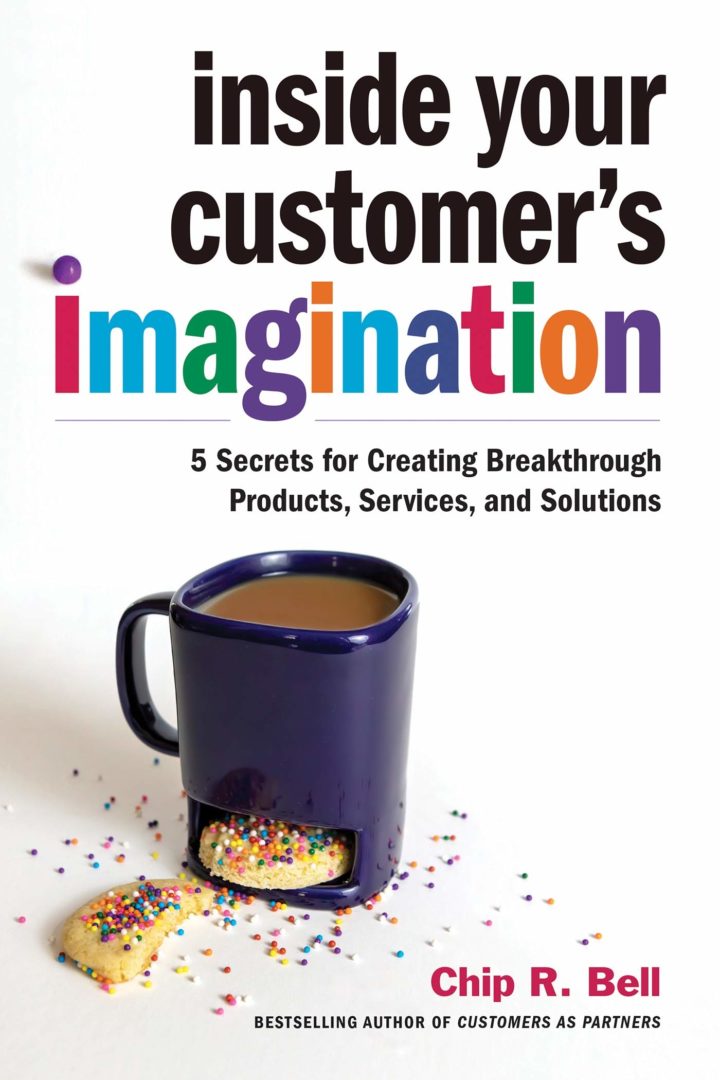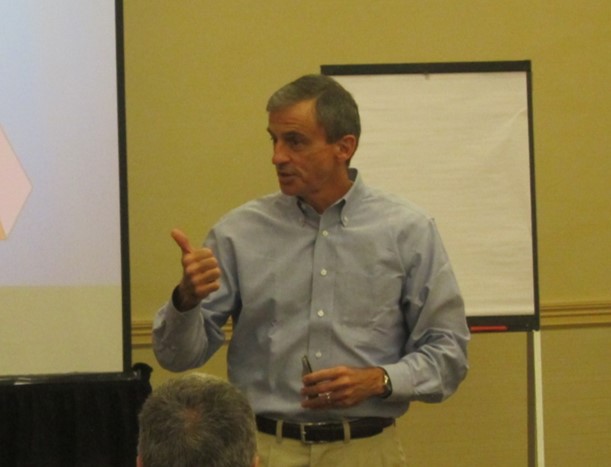True consultative selling is about selling with your customers, not to them. In other words, you work closely together in partnership to co-create value by eliciting the best thinking on both sides to create better ideas, stronger buy-in, and unshakeable relationships.
It’s a beautiful thing when it happens, but it’s also not common because it takes a rare mixture of relevant knowledge, interpersonal skills, and an outside-in mindset to make it work. I’ve written about that in my book, Bottom-Line Selling.
But there is more to the story than the quantitative and logical approach I advocate, and there is more value possible in co-creation than can be captured in a spreadsheet. That’s where Chip Bell’s new book, Inside Your Customer’s Imagination: 5 Secrets for Creating Breakthrough Products, Services, and Solutions, comes in.
Knowledge, skill and outside-in thinking may not be enough unless you can also get inside your customer’s imagination. The customer’s mind contains a potential treasure trove of ideas for working together to generate incredible value, much of which they may not even be aware of. The trick is to harness that imagination. Have you ever had a customer meeting that just sparkled with enthusiasm and produced ideas almost faster than you could write them down? This book will show you how to make that the norm rather than the exception.
The book is divided into five tactics for creating and sustaining a co-creation partnership, each with three techniques to apply them effectively. Bell calls them “secrets”, but I prefer to see them as plain common sense, creatively applied. They are:
Curiosity: The first step to selling with someone is to be curious about them. Chip says “curiosity is fundamentally an optimistic treasure hunt”, and it springs from a genuine desire to know as much as you can about them.
Grounding: Grounding is about establishing a shared purpose with your customer. It starts with defining the customer’s core need or aspiration.
Discovery: Curiosity and grounding are important to get started, but at some point you have to start generating ideas. Discovery is about creating a climate to make innovation possible—maybe even inevitable.
Trust: All innovation contains risk for both parties, so trust is essential. Both parties must trust each other enough to open up fully and generate ideas, and they must also trust each other enough to share the risks of implementing them.
Passion: Just like a marriage, a co-creation partnership needs to be nurtured with passion to avoid complacency and indifference. Passion ensures that both sides consistently bring their best.
This short synopsis does not do justice to the book. Chip uses excellent analogies and tons of compelling stories to illustrate and support his points, which makes for excellent reading. If you’ve ever had the chance to see Chip in person, you’ll see that he writes like he speaks, with a dynamic combination of entertainment and insight.
I had an intriguing email this morning from a podcast listener who asked me for examples of good questions to drive immediate personal connection. I replied that I don’t know any specifically, but fortunately I have some friends I can ask.
Google is one of those friends. Whenever I need a quick and superficial answer to a question, I can always count on it to help, or at least point me in the right direction. But if I want to dig deeper into an idea, I usually need more help than it can easily provide. The second problem with Google is that it only answers the questions I ask, and sometimes I don’t know exactly what I’m asking for.
When that happens, I’m fortunate to have an incredible network of friends I can turn to for deeper and better answers—friends who challenge my thinking, or remind me of something that I already know, or pose questions of their own. Sometimes they refer me to another friend who might have additional information.
My interests range pretty widely, beyond just my professional interest in sales and communications, and I pride myself on being a foxy hedgehog. Because of that, my network of friends reflects that diversity. Whether it’s psychology, philosophy, history, politics, economics, science, I have dozens if not hundreds of friends who are experts in each. Some I’ve known for a long time, some became my friends just this week. They come from all corners of the globe; they all give me their best thinking; and even those that I haven’t connected with for many years never hesitate to cheerfully try to answer my questions no matter what time or what day it is.
They’re always accessible because they actually live in my house, on the bookshelves that line every wall but one in my office. My friends are the authors whose books I’ve collected through the years. I don’t have an exact count, but I roughly estimate that I’ve got at least 2,000 friends with something interesting to say—closer to 3,000 if you count the ones that live in my Kindle.
I’ve written before that books are tools; but that doesn’t do them complete justice. I have many books that I consult regularly, on questions such as: What did Kahneman have to say about anchoring? Which of my sales friends has good examples of value propositions? What do Charlie Green or Robin Dreeke have to say about using questions to generate trust? What can Epictetus tell me today to help me deal with these crazy times?
They’re certainly not as quick as Google, but they can be orders of magnitude more helpful. And even if they don’t answer my question specifically, they almost always remind me why I’ve kept them around for so long. I can always get by with a little help from my friends.
This pandemic is teaching me that sometimes “constraints” can be turned into advantages.
Like everyone else in the training business, my client engagement calendar got vaporized starting the second week of March. One casualty was a full week of training that I had scheduled in Christchurch, New Zealand, for the end of last month. However, the client felt that the training was too important to put off entirely, so we worked out a plan to conduct the training virtually.
We both were confident that I could adapt the material to make it work in a virtual training environment, but we were not prepared for what we have seen so far.
We are now halfway through the material that I had planned to cover in face to face training, and every one of the sessions has gone better than almost any live training sessions I’ve delivered, when measured in one important way: how well are the participants picking up and demonstrating the skills taught?
My training has always been very hands-on, requiring the thoughtful completion of templates to identify and quantify the value that their products or services bring to their customers, and of course a lot of realistic role plays to translate that into effective sales conversations. In these sessions, I’m seeing more complete and deeply detailed work, and better execution during the role plays—certainly better than average.
One telling moment for me was when I checked with a team in one of the breakout rooms and noted that their work was not only spot on, but amazingly complete. I said as much, and one of them admitted that they had worked on the exercise before class started. “That’s cheating,” I said, “and I wish more of my students did that!”
Of course, so far the sample size has been too small to derive any definitive conclusions, but perhaps it’s worth considering what’s different and see if we can figure out what’s causing the improvement. Here are the main differences:
- Smaller chunks of training, so they could master one concept and-or related skill at a time. When clients have students and facilitator travel physically to a location, it makes sense to use as much of the time we have available together. That leads to day-long sessions, with a lot of material being presented. Now, we are limiting each session to two hours.
- Students got to “cheat” by getting with the material ahead of time. They get pre-reading and a condensed video of the lecture they are about to receive during the live virtual session.
- One week between sessions, in which they follow up on work they did in the session, send it to me for additional feedback, and get to practice the techniques with live clients in the interim.
What has stayed the same?
- I’ve been pleasantly surprised to find that I can still get the same level of engagement and class participation as in a live session. There are times I ask a question and don’t get a response, but then I just pick one of the faces on the screen and direct the question to that person. That keep everyone’s attention.
- The breakout room feature on Zoom allows teams to break into smaller groups for workshops, and I can pop in and out to see how people are doing, just as in a traditional classroom environment.
It’s working well on both sides. Their boss tells me his sales team looks forward to the weekly sessions. On my part, I’m probably working harder on virtual sessions than live ones, because of the preparation time between sessions. But as compensation, I do get to bypass the glamor and excitement of air travel, and that’s a trade I will gladly make most of the time![1]
In the face of sudden change, our best tools are adaptability, resiliency, and imagination. Without them, we face extinction. With them, we can survive and even thrive—and emerge stronger than before.
[1] Even if I don’t get to visit New Zealand for the moment.
In the past week or two, a new phrase has entered our common discussion: social distancing. I don’t know who came up with it, but I think it’s an unfortunate way to describe what we should be doing. I wish they had called it something like physical distancing.
Now is the time for social closeness, not distancing. Please don’t get me wrong; I’m not advocating doing anything unsafe, and I do take this coronavirus crisis seriously. But, precisely because we should take it so seriously, I advocate getting closer to the people who are important in your life—not physically but at least virtually.
It’s more important than ever to draw close. Having been through a number of hurricanes and their aftermaths, I’ve seen how difficult times can pull a community together as people pitch in to help each other without keeping score. Neighbors coming together and pooling their stored food for an impromptu cookout, running an extension cord to share some of your generator power, giving someone a gallon of gasoline, clearing trees off the road, and so on.
That kind of togetherness helps people in practical ways, but its true value is psychological, because it’s so much easier to cope with difficulties when you’re connected to something larger than yourself.
But this situation is different, because doing something for someone may actually put them in danger. A small example: when I went to retrieve my Sunday paper yesterday, I found it at my doorstep, thanks to a kind neighbor who likes to do that for people during her early morning walk. Normally, I’m grateful for that, but this morning, the first thing I did after taking the paper out of its wrapper was wash my hands for twenty seconds (although I forgot to sing “I Will Survive”). I bring my mother groceries so she won’t go to the store herself (and she is the most stubborn and independent-minded 97-year-old you will ever meet), but that increases the risk that I might bring the bug to her. You can’t eliminate all the risks but you can at least try to be smart about it.
Fortunately, we’re the first generation in history that has the means to undergo physical distancing and still stay socially close. We are better equipped than ever before to handle physical isolation, because at least we have Facetime and other ways to stay in touch. Let’s use our social media, phones, video streaming for their highest and best use: actually getting closer to one another.
Call your parents, or your kids or your grandkids. Call that old friend you haven’t talked to in quite a while, and see how they’re doing. Check on your neighbors to see if they need anything. We may not be able to shake hands, but we can still reach out and touch someone, as the old AT&T commercial used to urge us.
Physical distancing? Of course! Social distancing? No way!






